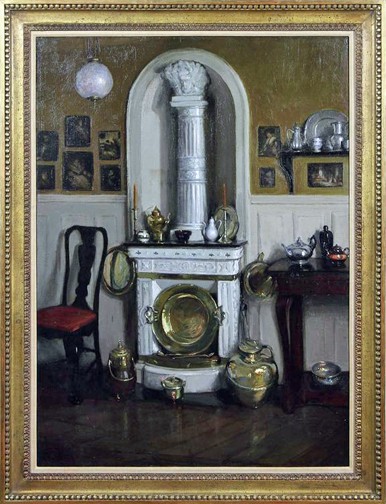Frances Thomason, 1866 – 1939
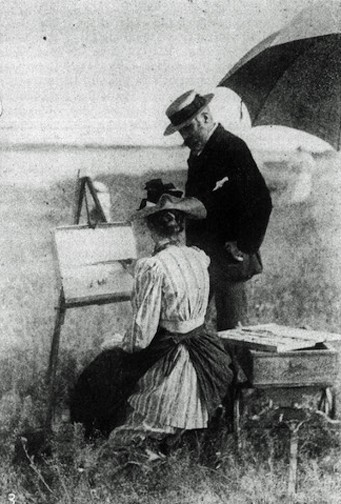
Frances Quarles Thomason was a painter born in Van Buren, Arkansas around 1866. She is sometimes referred to as Francis and identified as a male artist, while her middle name sometimes appears as Quorles. Even the Historic Arkansas Museum, which chronicles the heritage of her home state, spells her name as Francis.
Her parents were Hugh French Thomason, a former Confederate congressman and Arkansas state senator, and his first wife, Margaret Bostick Thomason, who died when Frances was very young. Little is known about her early life and education. A near-contemporary source from 1944 says that Thomason attended the University of Arkansas and then “lived in Paris for many years” (Hudson 334).
Before going abroad, Frances spent time in the 1890s at the Art Students League in New York, studying under John W. Alexander and William Merritt Chase (Hudson 334). Thomason also joined Chase's summer art colony at Shinnecock, Long Island, the first open-air art school in the U.S., which operated between 1891 and 1902. The Arkansas Democrat reported on December 15, 1900 that she had been studying in New York for nearly ten years and that she had been awarded a $100 prize at the latest student exhibition at Merritt’s school. “Her many friends at her old home are gratified by her success and extend warm congratulations” (5). At a 1901 exhibition of the Society of American Artists in New York, her painting “Shinnecock Road” was praised in Harper’s Bazaar as “sincere, strong, and holds together” (Abecket 1072). After her stay in New York, Thomason moved to Paris to "try her wings"... and she never left, spending the next four decades in her adopted city (New York Herald European edition, November 22, 1925, 4).
Many scholars have incorrectly concluded that Thomason lived in Paris for just ten years, leaving in 1915 as WWI intensified (i.e. Dennison 36). But historical newspapers and archival research show that Thomason remained in Paris through the war, into the 1920s and 1930s, until she died at the American hospital in Neuilly in October 1939. Her Herald Tribune (European edition) obituary indicated that she was sixty years old (probably closer to 73), had lived in Paris for nearly forty years, and was to be buried at the American community cemetery in Neuilly-sur-Seine (New York Herald Tribune European edition, October 29, 1939 3).
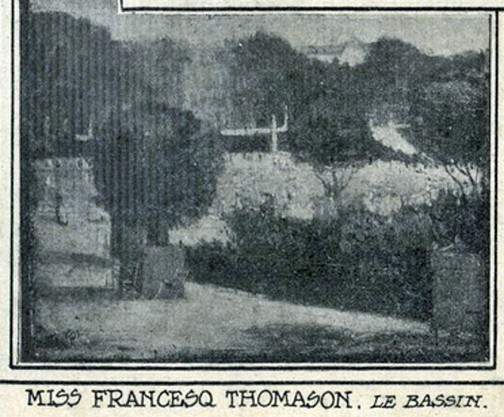
Thomason’s years in Paris were full. She formed lifelong friendships with other artists, both American and European, and established close ties with the American Girls’ Art Club. In those early days as an art student, Thomason made the acquaintance of Gertrude Stein and Alice B. Toklas, introducing fellow Girls’ Club resident Anne Goldthwaite to Stein and the world of modern art in 1906. In her unpublished memoirs, Goldthwaite described 4 rue de Chevreuse as "full of very interesting young women," one of whom was Frances Quarles Thomason, “a very handsome young woman and an arrivée.” According to Goldthwaite, "Artists are very good to young students and Miss Thomason took me under her wing to show me the ways of Paris" (unnumbered page from her unpublished memoirs).
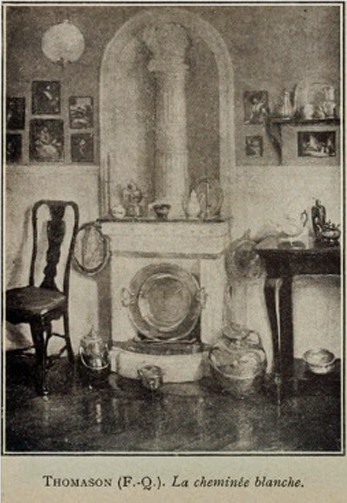
Thomason received a gold medal at the St. Louis World's Fair of 1904, also known as the Louisiana Purchase Exposition (Le Grand 1).
She participated in AWAA exhibitions at 4 rue de Chevreuse in 1904 and 1906, showing 3 works in 1904: "Luxembourg Gardens," "Out-Door Cafe," and "Along the Quai." These paintings were praised by Victor Ducieu in his review for L’Art (147-149). Though she had long since moved to her own studio and residence on rue Boissonade, she also participated in the 1914 AWAA exhibition, and her “six Parisian scenes” were praised as “particularly interesting and characteristic of the painter’s style” in the New York Herald European edition (February 22, 1914, 2).
Thomason also enjoyed the greater honor of having her work accepted by the Paris Salons, exhibiting an interior of a woman sitting at a window at the 1904 Salon des Beaux-Arts, another interior painting at the 1905 Salon des Beaux-Arts, and a third painting, “La cheminée blanche,” at the 1908 Salon des Beaux-Arts. This painting was also exhibited at the Carnegie Institute in Pennsylvania (date unknown) and was sold in the last two decades via auction, possibly to a state museum in Arkansas.
Like many of her Girls’ Art Club peers, Thomason showed her work at the 1907 Salon d’Automne, exhibiting four paintings: “Dunes de Hollande,” “Une terrasse,” “Au Luxembourg,” and “Les Toits.” In 1908, Thomason was awarded an honorable mention at the International Art Exhibition held at the Galerie des Artistes Modernes, 19 rue Caumartin (New York Herald European edition, May 10, 1908, 6). She was also listed among the exhibitors at the 1908 Salon d’Automne though it is unclear which of her works were shown (F.M. 79).
Frances Thomason was a fixture on the social scene of the American colony in Paris. Aside from her regular exhibitions at galleries and studios, including a private 1914 studio show on rue Notre-Dame-des-Champs that featured another Girls’ Art Club star, Blondelle Malone, Thomason appeared in the society pages at various receptions, teas, and lectures. She was also a frequent hostess for such teas and receptions, including one in January 1913 at 11 passage de Stanislas before she moved to a new residence (New York Herald European edition, January 11, 1913, 4).
Although we cannot say for sure if Thomason attempted to leave Paris at the outset of the first World War, we find her in July 1915 attending the funeral of Eleanor Thackara, wife of the American Consul-General in Paris and daughter of General William Tecumseh Sherman, at the Church of Saint-Honoré d’Eylau (The New York Herald European edition, July 22, 1915, 2). Thomason appears to have remained in Paris through the rest of the war and was active in charity efforts to aid wounded or homeless soldiers. In January 1919, she attended a YWCA reception of women war relief workers in Paris in honor of First Lady Edith Wilson (The New York Herald European edition, January 28, 1919, 2).
In his 1930 column “En Marge du Salon” [On the Fringe of the Salon], Robert Le Grand entitled an article about Frances Thomason, “Un impardonable oubli” (An Unforgivable Oversight). He professed his deep dismay at the fact that the French government had not honored Thomason’s service to the French war effort. She had been among the first to open a shelter for homeless French and Belgian soldiers on leave from the front, helping over eight hundred men with food, clothing, and even money. Le Grand maintained that once the war had ended, her services were quickly forgotten… and to make matters worse, her landlord had asked her to leave her studio in 1928 because she was a “foreigner.” In response to Le Grand's consternation, Thomason showed him the military cross one of her “adopted sons” had given her, proclaiming that it was recognition enough. But at the end of his article, Le Grand appealed to the Director of the Musée du Luxembourg to make amends by acquiring one of Thomason's paintings for the collection. Whether or not this happened remains a mystery.
In the 1920s and 1930s, Thomason was involved in a number of exhibitions, including several at the American Women’s Club in Paris, located at 61 rue Boissière. In September 1920, she was among several "distinguished American women artists" who were invited to exhibit their work at the American Art Association. According to a review in the Chicago Tribune, she showed "some nice landscapes - one in particular being a lowland with a lofty decorative tree." Some of the other exhibitors included Girls' Art Club affiliates Elizabeth Nourse, Grace Ravlin, and Matilda Brownell (September 3, 1920, 2).
Thomason's paintings were also featured alongside those of Cecilia Beaux, Elizabeth Nourse, John Singer Sargent, and James Abbott McNeill Whistler in a 1932 Women’s Club show, “Exhibition of American Art in France.” Sculptures by Frederick MacMonnies and Janet Scudder were also included (The American Magazine of Art, August 1932, 125). A 1927 review of an exhibition of American art at the Seligman Gallery on rue St. Dominique listed Frances Thomason as one of the “few distinguished artists” represented in the show (The American Magazine of Art, October 1927, 571). Despite living in Paris for so many years, she was still recognized as an American artist and was among the painters who sent works to Pittsburgh for the 22nd annual International Exhibit at the Carnegie Institute in 1923 (The Art News, March 24, 1923, 8). She had also exhibited paintings nearly every year before World War I at the renowned shows of the Pennsylvania Academy of the Fine Arts.
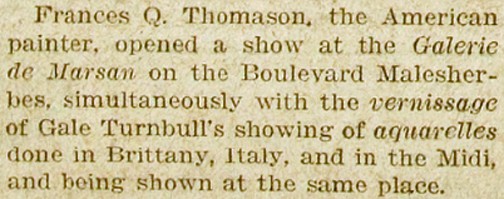
Though the Paris Salons had suspended exhibitions during World War I, these major annual events resumed in the postwar era. Thomason frequently participated, showing paintings (mostly landscapes) in the Salon des Beaux-Arts in 1920, 1921 and a number of other years (The Chicago Tribune Paris edition, April 13, 1921, 3). In a review of the 1920 Salon des Beaux-Arts published in The Christian Science Monitor, Thomason was described favorably: “One of the most conscientious painters in Paris is Frances Thomason, who has sent an admirable study entitled ‘Pont Saint Louis’ and an interior in which green is the dominant note” (September 20, 1920, 12). A comprehensive review of the 1922 Salon des Beaux-Arts published in Journal des débats politiques et littéraires tells us that her work could be seen in Salle 8, though it does not name specific paintings (Sarradin 5). In 1929, the Salons of the Société nationale des Beaux-Arts and the Société des Artistes Francais opened at the same time at the Grand Palais, and Thomason was among the 96 Americans who exhibited their work (The Chicago Tribune Paris edition, May 1, 1929, 2).
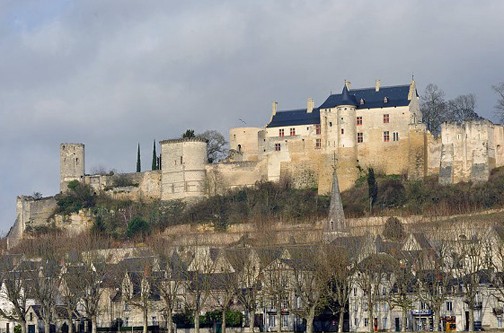
As a more established artist in the 1920s, Thomason could leave behind her Paris studio for winters in Saint-Paul-de-Vence and summers in Touraine, two very different but equally beautiful parts of France which inspired many of her canvases. It was first reported in March 1921 in The New York Herald European edition that Frances Thomason had a summer studio in Chinon, in the so-called “Chateau Country." Though the author of the article had praised Thomason’s ability to paint interiors: “she has the faculty of painting rooms in which it would be delightful to live,” her landscapes of Touraine really captured the attention of the viewer. There was also a wonderful description of her studio in Chinon:
Miss Thomason’s studio is high above the town, on the site of Fort Saint-Georges, the old fortress adjoining the castle of the Plantagenets, where Joan of Arc made her way years ago with her important commission to the King. Much of her painting is done there, but she sometimes makes her way down the hillside through the quaint streets and past the house were Richard Coeur de Lion died. She tells of the courtesy of the children of Chinon, who made a solemn resolution among themselves that they would not disturb her at her easel despite their curiosity. She intends to return to Chinon for the summer after the opening of the Salon, in which she is showing two landscapes. (March 20, 1921, 2)
In October 1922, Thomason’s connection to Touraine once again made the papers. The New York Herald European edition art critic declared, “For every landscape painter born, there seems to be a corner in the world waiting to bring out his latent abilities. Touraine appears to afford Miss Frances Thomason her best opportunities. Few painters have exploited this so-called Garden of France, where the picturesque yields to a calm and elegant harmony” (October 29, 1922, 2).
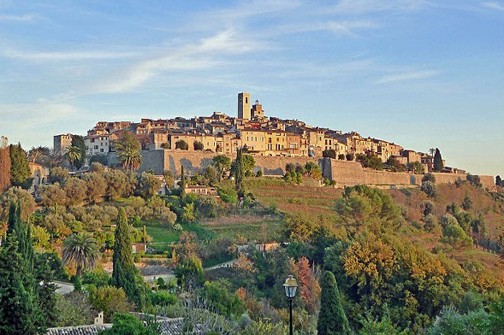
Winters in Saint-Paul-de-Vence (known at that time just as Saint-Paul) gave Thomason unfettered access to the magnificence of the Cote d’Azur and the medieval beauty of towns on the French Riviera. In January 1926, The New York Herald European edition reported that Thomason was likely to return to Paris with “more pleasant panoramas of French hill towns” (January 1, 1926, 2). According to the Herald’s art critic, a few months earlier at her solo exhibition at the Galerie Marsan, Thomason’s canvases “showed a particular feeling for the quaintly-terraced towns of the southern provinces.” Another Herald article, published on April 13, 1926, revealed that Thomason had been the “working companion” of fellow Montparnasse artists Frederick Boyd Waters and Emily Waters at Saint-Paul (F.G. 2).
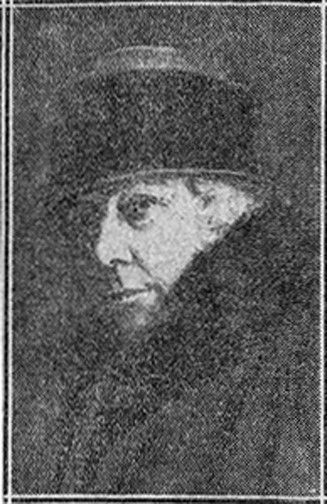
By the last decade of her life, Thomason was a well-respected senior member of the American art community in Paris. When painter Alexander Harrison, “‘Montparnasse’s Grand Old Man’” and a former judge at several AWAA exhibitions, died in 1930, Thomason was listed as one of the “scores of prominent residents in Paris” who attended his funeral at the American Church on the Quai d’Orsay (The Chicago Tribune Paris edition, October 17, 1930, 8). Her home, located at 1 rue Léopold Robert since at least 1915, became a meeting place for Americans young and old who were interested in the arts. In October 1922, Thomason hosted a reception where fellow artists could meet Boston sculptor Bashka Paeff and her sister Anna, a piano student at the New England Conservatory (The New York Herald European edition, October 1, 1922, 2). Louise Morgan Sill reported on a private exhibition hosted by Thomason in her studio for a young Australian artist, Maud Sherwood, who was a member of the Salon des Indépendants (The American Magazine of Art, December 1928, 701). Thomason was still showing her own work during these last years, exhibiting a landscape in 1936 at the exhibition of the European chapter of the American Artists Professional League at 261 Boulevard Raspail (New York Herald Tribune European edition, May 13, 1936, 5).
Frances Thomason died of unknown causes at the American hospital in Neuilly in October 1939. Her funeral was conducted by Rev. Clayton E. Williams at the hospital and burial soon followed (The New York Herald European edition, October 29, 1939, 3). Though she had been an important, long-standing figure in the American colony in Montparnasse, Thomason’s death came six weeks into World War II, denying her the proper funeral that an elder stateswoman in the community would have ordinarily been accorded. Sadly, there is almost no extant record of the many landscapes and other works that she painted. One can only hope that more of her oeuvre will resurface with the passage of time and the rediscovery of her artistic merit.
Sources
- “96 U.S. Artists Exhibit in Salon.” The Chicago Tribune Paris edition, May 1, 1929, p. 2. Gallica.
- Abecket, John J. “Exhibition of the Society of American Artists.” Harper’s Bazaar, vol. 34, no. 16, April 20, 1901, p. 1072. ProQuest.
- “American Artists Here Exhibit Paintings, Etchings, Sculptures.” New York Herald Tribune European edition edition, May 13, 1936, p. 5. Gallica.
- “American Artists in New Salon.” The Chicago Tribune Paris edition, April 13, 1921, p. 3. Gallica.
- “American Artists in Paris Exhibit.” The Christian Science Monitor, September 20, 1920, p. 12. ProQuest.
- “American Painters Invited to Carnegie.” The Art News, vol. 21, no. 24, March 24, 1923, p. 8.
- “American Women Artists Show Pictures of Merit.” The New York Herald European edition, February 22, 1914, p. 2. Gallica.
- “Art and Artists.” The New York Herald European edition, October 1, 1922, p. 2. Gallica.
- “Art Prizes Awarded.” The New York Herald European edition, May 10, 1908, p. 6. Gallica.
- Dennison, Mariea Caudill. "The American Girls' Club in Paris: The Propriety and Imprudence of Art Students, 1890-1914." Woman's Art Journal, vol. 26, no. 1, Spring-Summer 2005, pp. 32-37. JSTOR.
- Ducieu, Victor. "American Woman's Art Association of Paris." L'art, vol. 63, no. 773, March 1904, pp. 147-149. Google Books.
- F.G. “Round the Studios.” The New York Herald European edition, November 22, 1925, p. 4. Gallica.
- F.G. “With Latin Quarter Folk.” The New York Herald European edition, April 13, 1926, p. 2. Gallica.
- F.M. “Au Salon d’Automne.” L’Art et les artistes, vol. 8, October 1908-March 1909, pp. 79-83. HathiTrust.
- Falk, Peter H. “Thomason, Frances Quarles.” Who Was Who in American Art 1564-1975: 400 Years of Artists in America, volume 3. Madison, CT: Sound View Press, 1999, p. 3284.
- Goldthwaite, Anne Wilson. Unpublished Memoir. ca. 1910-1939. Archives of American Art, Anne Goldthwaite Papers, 1910-1950, Series 1, Box 1, Folder 1.
- “Harrison Funeral Attracts American and French Friends.” The Chicago Tribune Paris edition, October 17, 1930, p. 8. Gallica.
- Hudson, Ralph M. “Art in Arkansas.” The Arkansas Historical Quarterly, vol. 3, no. 4, Winter 1944, pp. 299-350. JSTOR.
- Le Grand, Robert. "Un impardonable oubli." L'événement, May 17-18 1930, p.1. Gallica.
- “Many Friends of Mrs. A.M. Thackara Gather for Funeral Service in Paris.” The New York Herald European edition, July 22, 1915, p. 2. Gallica.
- “Miss Frances Thomason, American Artist, 60, Dies.” New York Herald Tribune European edition, October 29, 1939, p. 3. Gale International Herald Tribune Archive.
- “Paris—American Art.” The American Magazine of Art, vol. 25, no. 2, August 1932, p. 125. JSTOR.
- “Personal Intelligence: American Quartier Latin.” The New York Herald European edition, January 11, 1913, p. 4. Gallica.
- “Round the Studios.” The New York Herald European edition, March 20, 1921, p. 2. Gallica.
- “Round the Studios.” The New York Herald European edition, October 29, 1922, p. 2. Gallica.
- Sarradin, Edouard. “Le Salon de la Société Nationale des Beaux-Arts.” Journal des débats politiques et littéraires, April 13, 1922, p. 5. Gallica.
- Shinkman, Paul. “Latin Quarter Notes.” The Chicago Tribune Paris edition, October 10, 1925, p. 3. Gallica.
- “Shows Art To-Day.” The New York Herald European edition, October 7, 1925, p. 4. Gallica.
- Sill, Louise Morgan. “Paris Notes.” The American Magazine of Art, vol. 18, no. 10, October 1927, p. 571. JSTOR.
- Sill, Louise Morgan. “Paris Notes.” The American Magazine of Art, vol. 19, no. 12, December 1928, p. 701. JSTOR.
- “Van Buren Lady Honored.” The Arkansas Democrat, December 15, 1900, p. 5. Newspapers.com.
- “With Latin Quarter Folk.” The New York Herald European edition, January 1, 1926, p. 2. Gallica.
- “Y.W.C.A. Holds Reception for Mrs. Woodrow Wilson.” The New York Herald European edition, January 28, 1919, p. 2. Gallica.
